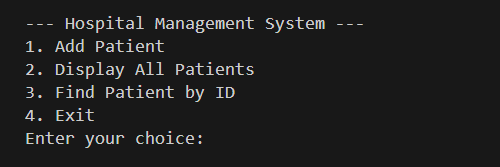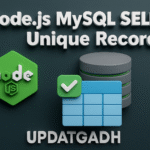
Hospital Management System in Python with Source Code
What is a Hospital Management System in Python
In today’s fast-paced world, hospitals face increasing challenges in managing their daily operations. With patients coming in for various treatments, managing records, appointments, and ensuring the quality of care becomes a daunting task. This is where technology steps in with solutions like Hospital Management Systems (HMS). Developed using programming languages like Python, an HMS streamlines hospital operations and ensures a seamless experience for both patients and healthcare professionals. Let’s dive into the essence of what a Hospital Management System is, how it can be developed using Python, and why it plays a crucial role in the healthcare industry.
Blood Pressure Monitoring Management System Using PHP and MySQL with Guide
Table of Contents
The Importance of Hospital Management Systems
Hospitals and healthcare facilities deal with an enormous amount of data—from patient details, doctor appointments, prescriptions, medical history, and billing, to staff management. Handling this data manually might lead to mistakes, delays, and inefficiencies. Hospital Management Systems offer a digital solution to manage all of this efficiently. They automate routine tasks, minimize paperwork, and improve data accessibility.
Why Python for Hospital Management Systems?
You may wonder, why Python? Python is known for its simplicity and versatility, making it the go-to language for many developers in creating applications. With a variety of libraries and frameworks, Python allows for rapid development, scalability, and the ability to handle large volumes of data—just the kind of functionality needed in a hospital setting.
Step-by-Step
1. Patient Management
The system starts with managing basic patient details such as name, age, gender, disease, and ID. Each patient is stored as an object, with all relevant information encapsulated within that object. This ensures that patient records are structured and easy to retrieve.
Source Code for a Simple Hospital Management System in Python
Here is a simple Python program that models a basic Hospital Management System:
class Patient:
def __init__(self, patient_id, name, age, gender, disease):
"""Initialize a new patient with ID, name, age, gender, and disease."""
self.patient_id = patient_id
self.name = name
self.age = age
self.gender = gender
self.disease = disease
def display_info(self):
"""Display patient information."""
print(f"Patient ID: {self.patient_id}")
print(f"Name: {self.name}")
print(f"Age: {self.age}")
print(f"Gender: {self.gender}")
print(f"Disease: {self.disease}")
class Hospital:
def __init__(self):
"""Initialize a new hospital with an empty list of patients."""
self.patients = []
def add_patient(self, patient):
"""Add a new patient to the hospital."""
self.patients.append(patient)
print(f"Patient {patient.name} has been successfully added.")
def display_all_patients(self):
"""Display information for all patients in the hospital."""
if not self.patients:
print("No patients found.")
else:
for patient in self.patients:
patient.display_info()
print("-" * 20)
def find_patient_by_id(self, patient_id):
"""Find a patient by their ID and display their information."""
for patient in self.patients:
if patient.patient_id == patient_id:
patient.display_info()
return
print("Patient not found.")
def main():
hospital = Hospital()
while True:
print("\n--- Hospital Management System ---")
print("1. Add Patient")
print("2. Display All Patients")
print("3. Find Patient by ID")
print("4. Exit")
choice = input("Enter your choice: ")
if choice == '1':
patient_id = input("Enter patient ID: ")
name = input("Enter patient name: ")
age = input("Enter patient age: ")
gender = input("Enter patient gender: ")
disease = input("Enter patient's disease: ")
new_patient = Patient(patient_id, name, age, gender, disease)
hospital.add_patient(new_patient)
elif choice == '2':
hospital.display_all_patients()
elif choice == '3':
patient_id = input("Enter patient ID to find: ")
hospital.find_patient_by_id(patient_id)
elif choice == '4':
print("Exiting the system. Thank you!")
break
else:
print("Invalid choice. Please try again.")
if __name__ == "__main__":
main()


How This System Helps Hospitals
This Hospital Management System may be simple, but even basic functionality like this can greatly enhance hospital operations. By having a digital system, medical records are stored securely, errors due to manual handling are minimized, and efficiency is boosted. Doctors can focus more on patient care, and administrative staff can manage data more effectively
hospital management system project python pdf
hospital management system project class 12 python pdf
hospital management system in python tkinter
hospital management system project with source code pdf
hospital management system project in python free source code
hospital-management system project in python github
hospital management system project in python ppt
hospital management system project in python and mysql source code
hospital management system project in python django github
hospital management system in python project pdf
hospital management system in python pdf
hospital management system in python example
hospital management system in python github
hospital management system in python geeksforgeeks
- New Project :-https://www.youtube.com/@Decodeit2
- PHP PROJECT:- CLICK HERE
Share this content:










1 comment